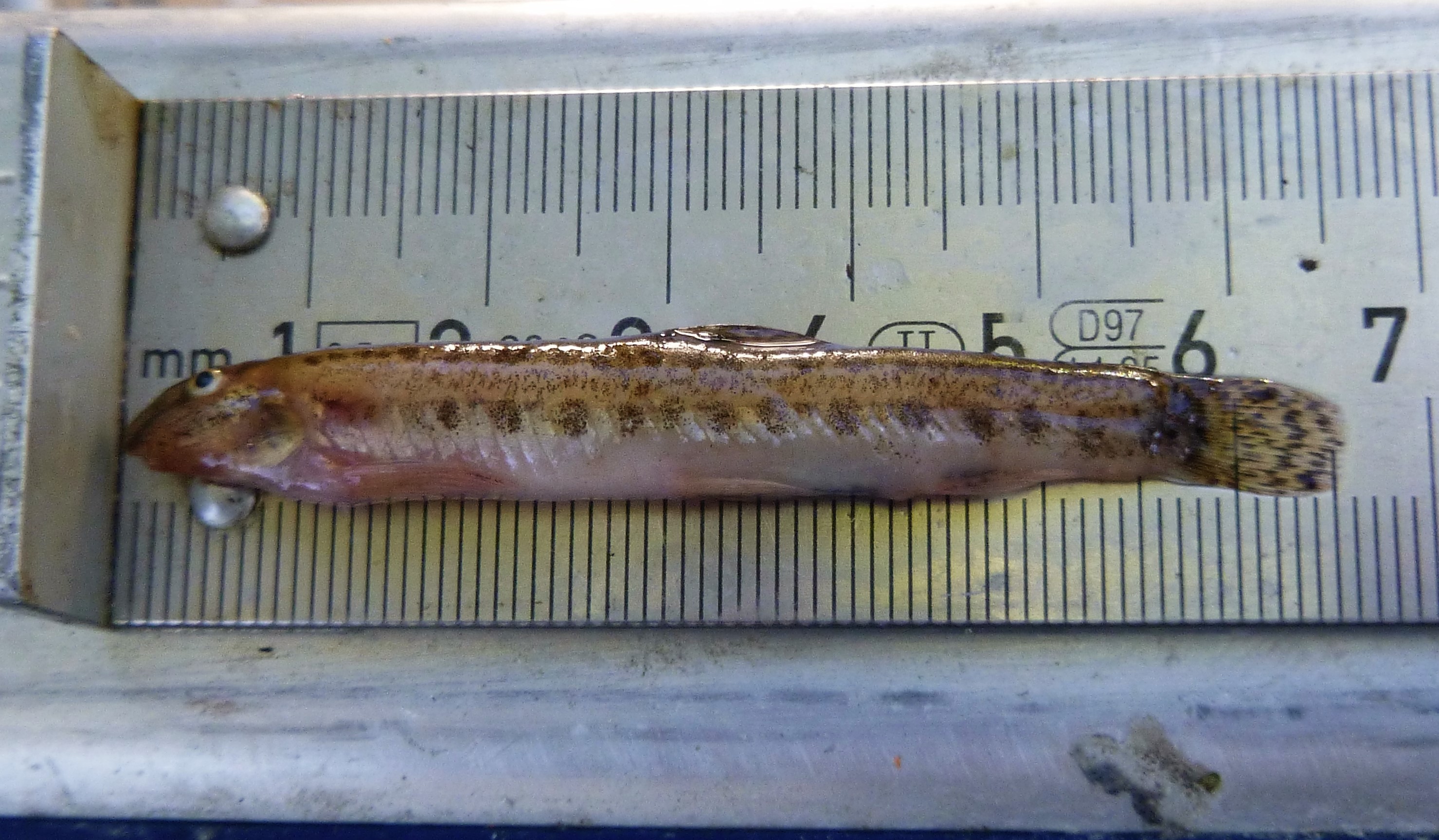Spined loach
- Category: Fish fauna - species
- Published: Wednesday, 26 October 2016 11:39
- Written by Super User
Spined loach
Cabitis taenia Linnaeus, 1758
Species description
Small fish belonging to order Cypriniformes. The body is elongated and flattened laterally, and has a bright shade of creamy yellow colour with numerous dark brown spots on the sides and back, which are arranged in four distinct stripes (Gambetta 1934, Nalbant 1933) (Photo 1.). Head constitutes on average 19% of the entire length of the body. There are three pairs of barbells around the mouth, two pairs on upper lips and one in corners of the mouth. Single comma-shaped spot on upper caudal base constitutes the diagnostic feature (Gąsowska 1962, Białokoz 1986). Sexual dimorphism is expressed by larger size of females which can reach 146 mm of the total length. There is a modification of pectoral fin rays in the form of a laminar projection (lamina circularis) on the dorsal surface of the second pectoral rays in males. The adult males can reach 75 mm of length, and their pectoral as well as pelvic fins are longer than in females. They also have higher dorsal and anal fins (Boroń and Danilkiewicz 2000, Lodi 1979).

Spined loach is on the list of animals being under partial protection in Poland (Regulation of the Minister of the Environment of 6 October 2014 on the protection of animals species, Journal of Laws 2014, item 1348). It is also a species of the European Community interest and therefore it is listed in the Annex II of the Habitat Directive (Council Directive 92/43/EEC of 21 May 1992 on the conservation of natural habitats and of wild fauna and flora).
Biology
Spined loach is a short-lived species. The oldest specimens can be six years old. Males live shorter and they are smaller than females. Females become sexually mature in their second or third year after hatching. The spawning season is from May to July. Fertility of females depends on the weight of individual fish. A female can lay between 112 and 4285 eggs in a number of portions (Boroń and Pimpicka 2000). Spawning takes place on the plants and on the plant debris. The eggs are left attached to plants by sticky cilia (adults do not look after their offspring). The embryonic development lasts 5 days at temperature 16-17ºC. After hatching, larvae produce sticky substance, which enables them to stay attached to plants. In the second day after hatching, they develop external gills (Robotham 1981). Spined loach is active at night, burrows in the substrate to rest or hide during daytime. Juveniles feed on zooplankton, while plants and bottom organisms are consumed by older fish. Cladocerans, copepods, ostracods, and chironomid larvae are the main components of their diet (Boroń and Boroń 1994).
Habitat
Spined loach inhabits both lentic and lenitic waters, where it prefers fine substrate (sand, mud). The species occurs also in oligotrophic lakes, where it inhabits places covered by soft organic substrate. Spined loach migrates to deeper waters (up to 1.5 m) during the winter, in response to seasonal changes of water flow and resulting erosion of surface substrate and siltation processes (Kohanowa 1957).
Distribution
Spined loach occurs all over Poland except mountain rivers. Cytogenetic studies shown hybridization with other, closely related species. Thus, one should refer to the species complex of the genus Cobitis (Vasil’ev i in. 1989, Boroń 1992, Boroń 1994, Vasil’ev iVasil’ eva 1994).
As a part of the project carried out by the Maritime Instiute in Gdańsk ”Pilot monitoring studies of marine habitats and protected species in 2015-2018", spined loach is monitored at 4 sites:
- Jezioro Bukowo,
- Jezioro Łebsko,
- Zalew Szczeciński,
- Zalew Wiślany/Zatoka Elbląska.
References
- Białokoz W. 1986. Koza Cobitis taenia Linnaeus, 1758. (in:) Brylińska M. (ed.). Ryby słodkowodne Polski. PWN, Warszawa, p. 321-324.
- Boroń A, Pimpicka E. 2000. Fecundity of spined loach, Cobitis taenia from the Zagrzyński Reservoir, Poland (Osteichthyes, Cobitidae). Folia Zool. 49 Suppl.: 79-84.
- Boroń A. 1992. Karyotype study of diploid and triploid Cabitis taenia (Pisces Cobitidae) from Vistula River basin. Cytobios 72: 201-206.
- Boroń A. 1994. Use of erythrocyte measurements to detected natural triploids of spined loach Cobitis taenia (L). Cytobios 78: 197-202.
- Boroń A., Boroń S. 1994. Diet of spined loach, Cabitis taenia (L) from Zegrzyński Dam Resorvoir Acta Ichthyol. Et Piscat. 125-139.
- Boroń A., Danilkieiwcz Z. 2000. Koza Cobitis taenia Linnaeus, 1758 (in:) Brylińska M. (ed.). Ryby słodkowodne Polski. PWN, Warszawa, p.339-343.
- Gambetta L. 1934. Sulla variabilita del cobite fluviale (Cobitis taenia) e sul rapporto numeric dei sessi. Boll. Mus. Zool. Anat. Comp. Torino 44: 297-324.
- Gąsowska M. 1962. Krągłouste i ryby. Klucze do oznaczania kręgowców Polski. PWN, Warszawa.
- Kohanova H.A. 1957. Razvite eipovki (Cobitis taenia). Vopr. Ichtiol. 8: 89-101.
- Lodi E. 1979. Variability of the Canestrini (Osteichthes, Cobitidae). Riv. ltt. Piscic. Ittop. A, XIV 3: 81-88.
- Nolbant T. T. 1993. Some problems in the systematic of the genus Cobitis and its relatives (Pisces, Ostariophysi, Cobitidae) Rev. Roum. Biol. Anim. 38: 101-110.
- Robotham P.W.J. 1981. Age, growth and reproduction of a population of spined loach, Cobitis teania (L). Hydrobiologia 85: 411-420.
- Vasil’ev V. P., Vasil’eva K. D. 1994. The karyological diversity in spined loach from genera Cobitis and Sabanejewia. Fishes and Their Environment. VII Congress Soc europ. Ichtyol., Oviedo.
- Vasil’ev V.P., Vasil’eva K.D. Osinov A.G. 1989. Evolution of a diploid-triploid-tetraploid complex in fishes of the genus Cobitis (Pisces, Cobitidae) (in:) Evolution and Ecology of Unisexual Vertebrates, (ed.) R.M. Dawley, Bogart J.P., New York State MuS. Albany Bull. 466: 153-169.





